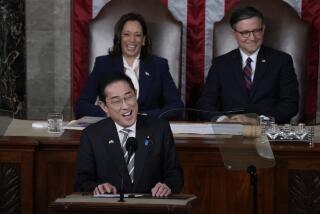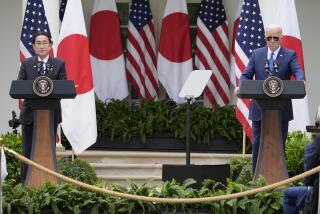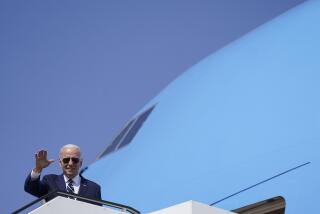Asia Trip Gives Bush Chance to Review Policies
- Share via
WASHINGTON — President Bush, embarking today on a whirlwind, 100-hour visit to Japan, China and South Korea, attends the funeral this week of the emperor who reigned in Japan during World War II and greets a dozen or so leaders whose cooperation he will need as he crafts a foreign policy for what he hopes will be a period of reduced global tensions.
Bush’s first major international journey as President offers mostly symbolic opportunities in the crucial Pacific Basin rather than the prospect of direction-setting initiatives. The more immediate impact may be on the home front, where Bush is fighting suggestions that his measured, deliberative approach to setting a foreign policy is allowing the nation to drift on the world stage.
‘Negative Approach’
“I simply don’t agree with that,” Bush said, with an edge to his voice, at a news conference Tuesday. “I really hadn’t ever heard such a negative approach to foreign policy.”
Declaring that “we have a foreign policy,” Bush said that the 17,000-mile trip will advance his process of carefully reviewing East-West relations, events in South America and the U.S. role in the Middle East as specific goals and courses are plotted.
There will be time for only brief meetings in Tokyo with no more than a dozen of the approximately 60 government leaders visiting Japan for the funeral of Emperor Hirohito. But the trip--according to White House National Security Adviser Brent Scowcroft--”is an opportunity to underscore not only the importance of the three countries that the President will be visiting to American interests, but also the growing importance of the U.S. relationship to Asia as a whole, and to point out, again, that the United States is an Asian power.”
At the same time, the high-profile appearance in international settings also presents a valuable opportunity in a more parochial realm. It is a chance to extend the honeymoon phase of the new presidency at a time when it is suffering the sorts of nicks and scratches that eventually dull the shiny veneer of a new Administration.
If shifting attention from controversies and criticisms in Washington “turns out to be a dividend, let it never be said (that) this Administration ever refused to accept a dividend,” White House Chief of Staff John H. Sununu said.
Growing Criticism
Criticism has been growing in Washington that the new Administration may be moving too slowly in developing foreign policy initiatives toward the Soviet Union, Nicaragua and other key nations and regions.
While Bush did not spell out specific policies that will be pressed on the trip, he said that U.S. policy in the Middle East is intended to encourage discussions between Jordan’s King Hussein and Israel. Bush plans to meet with Hussein, Egyptian President Hosni Mubarak and Israeli President Chaim Herzog in Tokyo.
Bush also intends to meet with key figures from Belgium, Brazil, France, Nigeria, Pakistan, Singapore, Thailand, Turkey, West Germany and Japan, said Scowcroft, in a schedule “that fills up almost every spare minute that the President has.”
“We’re going to try to see as many as possible, so the substance will not be extensive,” Scowcroft said in a briefing for reporters.
Officials have said that the topics will range from superpower relations and the complicated U.S.-Japanese relationship to the unsolved problems of Third World debt.
The importance of the trip is “not with how long the meetings necessarily are and how much substance, but the significance of a face-to-face opportunity to get, at least, out on the table a few issues for discussion,” Scowcroft said. “That’s very, very important, and it eases the sense of communication between countries after that if you’ve had this kind of personal contact.”
Courtesy Calls in China
In Beijing, several courtesy calls are being squeezed into a tight schedule but only one in-depth, lengthy session--with Premier Li Peng--is planned. A stop in Seoul on the way home from China is scheduled for barely four hours.
The six-day trip represents the latest phase in a presidency that, in its first five weeks, has unfolded in phases.
-- The first 10 days or so, the President’s aides say, offered the nation a view of who George Bush is, and the standards--particularly in ethical behavior--that he expects from those who work for him. The ethics question, however, reflected unfavorably when two of his closest advisers, Secretary of State James A. Baker III and White House counsel C. Boyden Gray, encountered pointed criticism over their initial reluctance to release control over their substantial financial investments.
-- Next came the unveiling of his fiscal 1990 budget priorities, meant to put some flesh on the vision of a “kinder and gentler” America that he drew during the presidential campaign. But he did not highlight any central themes of his proposal, provoking complaints from Democrats that he had turned over to Congress the political liability of deciding which programs to cut.
-- Now the focus turns to foreign affairs, as the White House takes advantage of the timing of Hirohito’s funeral during a politically difficult period in Washington when the Senate is focusing on the embattled nomination of former Sen. John Tower to be secretary of defense.
Seeking Direction
Throughout it all, the Administration has been weighing the direction it intends to pursue in foreign policy, even as it continues to assemble its national security group at the Pentagon and State Department.
Asked for evidence that the United States had set a course for its relations with Asia, Scowcroft conceded that it is “unfortunate that the President doesn’t have his national security team in place as yet,” but he said sarcastically at a White House briefing for reporters:
“One month after he’s come into office we’re already worrying that he’s not charging off in all directions with finished policy.
“I believe the President is not trying to make quick headlines. What he is trying to put into place is a foreign and national security policy which will look forward . . . toward the end of the century and try to set in place near-term actions which will aid us in where we think we’d like to be at the end of the century.”
For his part, Bush said he is undismayed by such developments as the current Middle East tour of Soviet Foreign Minister Eduard A. Shevardnadze.
“I don’t want to be stampeded by the fact that the Soviet foreign minister takes a trip to the Middle East. In my view, that’s a good thing,” he said, adding that he envisioned “a limited role” for the Soviets in that troubled region.
As for the timing of his own trip, of course, Bush had no choice.
Once the Japanese announced that the funeral for Hirohito, who died Jan. 7, would be Feb. 24, the only question for the President was whether to attend--a decision about which there was little debate, given the importance of Japan to U.S. policy in Asia and to the global economy, White House aides said.
Indeed, in the view of White House officials, others who are advising Bush and such outside observers as Stephen Hess of the Brookings Institution, the timing provided an opportunity.
‘Too Many Glitches’
“His takeoff hasn’t been flawless. There have been too many glitches,” said Hess, a student of the presidency since the Administration of Dwight D. Eisenhower. “Here’s an opportunity to ‘Come fly with me,’ get above Washington and look like a statesman.”
While the President and his staff have yet to be caught in the grip of the sort of crisis atmosphere that invariably takes over the White House from time to time, there have been political crises of sorts, seen and unseen.
“Obviously, they’re still learning,” said Rep. Richard Cheney (R-Wyo.), the assistant House minority leader and chief of staff in the Gerald R. Ford White House. “There’s a shakedown process under way. They’re learning. Give them a little bit of time.”
There was the quickly aborted plan to charge savings and loan depositors a fee on their savings to help bolster the sagging S&L; industry. And there were questions that flared up and then vanished as the White House mobilized behind the scenes to defend the Cabinet nominations of Housing and Urban Development Secretary Jack Kemp, since confirmed by the Senate, and Louis W. Sullivan, who has yet to face Senate hearings as Bush’s choice for secretary of health and human services.
Then, the nomination of Tower to be secretary of defense ran into a wall of allegations and doubt that has not yet been resolved.
“Personally, I’m very upset. I don’t think this is any way to start a new Administration,” groused one White House newcomer, recognizing the need for what he called “some serious damage control.”
Others, taking their cue from the President, say that the controversies have not diverted them from the initial tasks of setting the Administration on course. Indeed, they say, the Asian trip represents an opportunity to chart a course in a crucial part of the world without distracting them from more pressing domestic issues.
“The White House is reeling. The White House is spiraling,” a senior White House official muttered mockingly as he walked down the silent corridor just beyond the Oval Office on a day when the allegations about Tower were particularly bothersome. “I don’t notice much reeling. I don’t notice much spiraling.”
A VISIT TO ASIA
President Bush’s trip to three Asian capitals will include these visits:
TOKYO
Akasaka Palace--Modeled on the palace at Versailles and on the Louvre, it was completed in 1909 to be the crown prince’s residence. Emperor Hirohito, whose funeral Bush will attend Friday, lived at the palace before he ascended the throne in 1926.
The Imperial Palace--The main ceremonial building within 284 acres of ponds, moats and forests in the center of Tokyo was built in 1968 to replace a structure destroyed in World War II. In the 17th Century the complex was the headquarters of the Tokugawa Shogunate that ruled Japan.
Shinjuku Imperial Gardens--This park, the site of Hirohito’s funeral services, once served as the garden for the imperial household.
BEIJING
Great Hall--Built for the celebration of the Communist government’s 10-year anniversary in 1959, it sits on Tienanmen
Square in the traditional heart of the city and is the site for all major gatherings.
Zhongnanhai--A 213-acre compound that includes two large lakes that used to be part of the imperial palace grounds, it now serves as Communist Party headquarters.
Chongwenmen Christian Church-- Bush is expected to attend services at this Protestant church.
Los Angeles Times
SEOUL
The Blue House--The nation’s presidential residence since the Republic of Korea was formed in 1948.
The National Assembly--Home of South Korea’s unicameral legislative body.
Yongsan garrison--Actually a city within a city, this is headquarters for the Combined Forces Command, the U.S. Forces Korea, the U.S. 8th Army and the United Nations Command.
More to Read
Get the L.A. Times Politics newsletter
Deeply reported insights into legislation, politics and policy from Sacramento, Washington and beyond. In your inbox twice per week.
You may occasionally receive promotional content from the Los Angeles Times.








